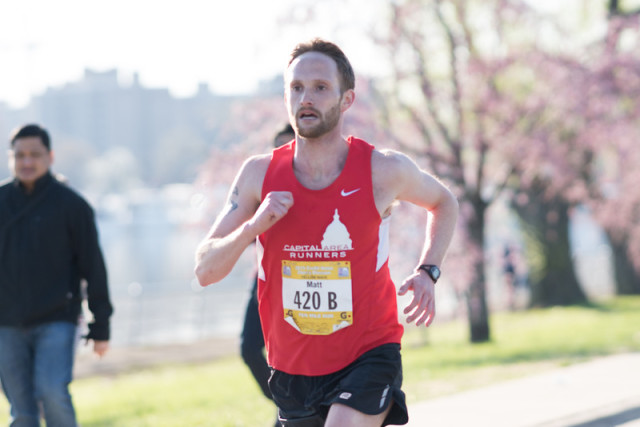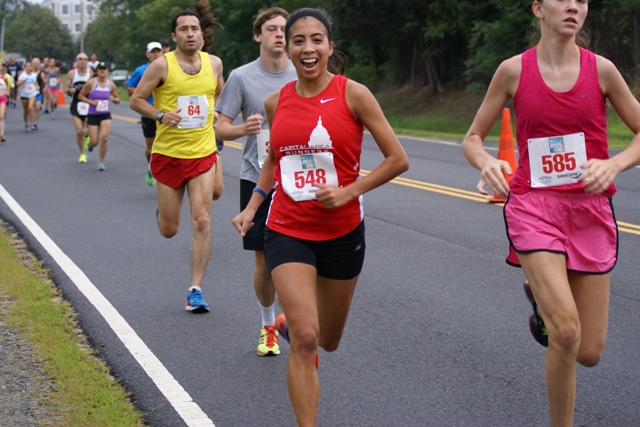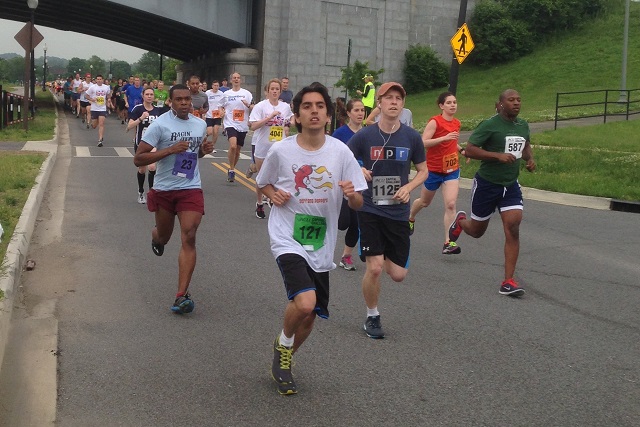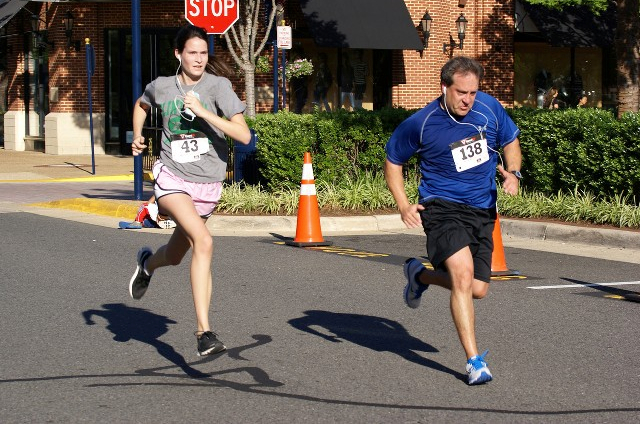
In the months leading up to 2015’s Fall marathons, RunWashington will follow several local runners as they prepare for their races. We’ll chart their progress as they train their legs, lungs and minds for the challenges they’ll race on race day. Each week, we’ll catch up with our runners and see how they’re doing. Matt Deters is an Arlingtonian who resumed running seriously a few years ago and has improved rapidly. Given his druthers, he’d already have retired from the marathon, but he’s giving it another shot.
Matt Deters has already run his perfect marathon…almost. And as anyone who cares about running knows, almost doesn’t matter.
Last spring was a great season for Matt Deters. He consistently peeled off intense, competitive speed, tempo and long run workouts with his Capital Area Runners (CAR) teammates. He posted a 1:09:45 at the Shamrock Half and a 48:45 at the truncated Cherry Blossom 9.39 miler.
Teammate Greg Mariano has observed Matt’s improvement leading up to last spring’s season. “It seemed like it came out of nowhere. Obviously it didn’t – he was putting in the miles and working hard, but, in the fall I was lapping him in tempo runs and by the spring we were running together.”
Deters was primed for a great race when he showed up to April’s Glass City marathon in Toledo, Ohio. He was ready to reach his goal of 2:30. His previous PR was a 2:50, and he was prepped to blow it out of the water. The goal is a personal one – just something the 30 year old Arlington resident thinks he can do but won’t be easy “running is almost always arbitrary,” he says, when, like him, you’re fast but not at the Olympic level.
Deters was well on the way to his mark, hitting 5:40s consistently all the way to the 21 mile point. He pushed the pace, passing the fifth place runner. A little more than 2.5 miles after taking a right at the direction of a course marshal, he realized he was supposed to have been pointed left.
Mariano was also on the course that day, and was also misdirected, by a bike escort in his case, though he didn’t go as far off course as Deters and did end up with a third place finish. Mariano describes his own mood as agitated, but, of Matt, he laughs and said, “his attitude was better than mine.”
“Life is really ironic sometimes,” Deters said he remembers thinking to himself at the time. Three days later, he signed up for November’s Philadelphia marathon.
Deters is looking forward to achieving his goal this fall by following the same plan as he did this spring with his CAR teammates. “I have a great group of guys to train with,” he says. Teammates Greg Mariano and Doug Smith are training for California International two weeks after Philly, so their training schedules will coincide.
Another bonus of choosing Philly – it’s a big city race, so, he said, “I won’t get lost.”
Deters credits running with CAR as the impetus for a turning point in his training. Meeting three days a week for tempo runs, long runs, and hill or interval training, the men he races with are a good group, and they push him to work harder.
Greg Mariano agreed. “We have a really good group dynamic, we really want to succeed as a team, and we train like that,” he said. “Even though we compete against each other, it’s more supportive than competitive.”
Running has been a part of Deters’ life since he was in middle school. “I was the fat kid,” he said simply, growing up in his small town of Ottowa, Ohio, “(he was) made fun of, last picked for kickball, all those clichés were true.”
In the seventh grade, he joined Weight Watchers with his mom, lost weight, and grew. He started sneaking out to the track at night to run in the dark because he was embarrassed to be seen exercising. The next year, one of his friends forged his name on the sign-up sheet for the track team. He didn’t want to do it at first, but stuck with it.
Deter went from one of the lower performing athletes on the team to winning league and districts in the 1600 meters his junior year. His first battle with injury came in high school, when a bout with the plantar fasciitis he still has to fend off periodically sidelined him.
He ran as a walk-on at Ohio University his freshman year, but when he transferred to Bowling Green University he needed “time to work and drink,” as he put it. Driving for UPS and going to school kept him busy.
Shortly after college, when he was 24, Deters got back into running. He was enjoying reconnecting with “that positive vibe you get from running.” Then he took a fall so severe it sheared the cartilage off his femur, and ended up needing surgery to repair micro fractures around his knee.
Two years later, he ran the Marine Corps marathon just shy of three hours. “It was terrible, I hit the wall and everything.” At the time, he was putting in 40-50 miles a week. He says he really got back into running in 2013 when he joined CAR.
He says it’s a whole different ballgame, pointing to teammates as a motivating factor in his training, “you have those guys at a workout right by you and they’re just pushing it,” it makes him work harder, Deters asserts. He also credits teammate Susanna Sullivan with introducing him to pool running, which he began using as a recovery tool, but now features prominently in his training.
In addition to three workouts a week with his team, Deters gets his miles in most days to and from work. He treks from Arlington to Foggy Bottom on his running commute, does a core workout and has nine miles under his belt by the time he assumes his post at his office in financial assistance at GWU.
He likes commuting via running because “it saves so much time, and it forces you to do it – there’s no way you’re not putting in the miles.”
Between now and his 14 week training cycle that will start in August, Deters is working on speed, doing 5ks and finessing his turnover. He’ll also get ready to bump his current mileage of 70-80 miles per week to anywhere from 90-105 miles. He’ll continue with his core and foam rolling routines and, hopefully, recreate a Glass City-caliber performance for a full 26.2.

It was time, and Kelly Swain knew it.
“I was always working up to a marathon,” she said just a month before toeing the line at the Marine Corps Marathon.
The 29-year-old Burke native has been running since high school, but wanted to wait for the right moment to commit to 26.2 miles. She started running while at Lake Braddock, encouraged by her older sister’s achievements, but quickly became successful in her own right. That sister, accomplished local runner Erin Taylor, recalls “some middle school race, or high school, [Kelly] either won the mile or got second. I was like, ‘People think I’m fast? She’s gonna be way faster.”
Swain went on to run at the University of Virginia, but injuries and the pressures of collegiate running kept her from the “normal college experience” she wanted, the kind where your peers aren’t working like professional runners to maintain their scholarships. She declared herself retired.
“I just needed a break and didn’t think I really liked running any more,” she said.
She’s not alone.
“A lot of these runners come out of college programs burnt out,” said George Buckheit, Swain’s coach with Capital Area Runners. “They just feel like running isn’t fun, and I think one of the strengths of what we put together at Capital Area Runners is we’ve got a group that is very supportive.” This has been a selling point for Swain’s return; both sisters praise Buckheit and their teammates for the motivational atmosphere that sets them up for their success.
“The Ultimate Progression”
“When I came back to running three years ago, I promised myself I would not let it consume my entire life,” Swain said.
Instead of cutthroat competition, she made the choice to set time goals and encourage runners who might pass her.
“I think when I took the focus off of competing with other runners and placed it on my own ability, I started loving running once again,” she said.
Still, to her, the marathon was “the ultimate progression” in a runner’s career and her unspoken goal was to finish her first in under three hours. To get there, she spent two years rebuilding her base with CAR and the last year racing the Army Ten-Miler, the Richmond Half Marathon, and most recently, the Navy-Air Force Half Marathon. Her times show little hint of having recently come out of retirement. In fact, she won the Marine Corps 17.75k in March and placed fifth at the Navy-Air Force Half-Marathon. But she had to rebuild her confidence alongside her mileage before she considered going farther.
“I didn’t want to just do a marathon to do it,” she said. “I wanted to do a marathon to know that I was going to run well and that I was well prepared.” Doing well, for her, meant being thoroughly prepared to break three hours. “I guess this is the year that I thought I was ready to do that,” she said, with characteristic humility. Because runners love a challenge, she also scheduled her wedding to to fiancee, Brendan Mahoney, for Nov. 1, 2014, just six days after her marathon.
With any luck, the post-race soreness will wear off before it’s time to dance.
“I never make any bold predictions on a race, especially a marathon,” Buckheit said of her upcoming race. “It’s so unpredictable. But she’s running great. This is as well as she’s been running since she’s been with us.”
Swain is also running her highest mileage ever, and without injury, which Buckheit attributes to better recovery practices.
“She’s ready,” Taylor said. “She knows how hard a first marathon can be, especially if you go out too fast like I tend to do and then you’re pretty much crawling in. She’ll run better than I did my first.”
Taylor’s pride in her sister shines through every praising word she said. “That week is going to be amazing for her,” she gushed.
Race Day
On marathon morning, Swain plans to heed the advice of her coach to start slow and finish fast. She attributes her success at the Navy-Air Force race to staying slow through the first 5k, per Buckheit’s advice. “I never believed him at first until I actually started to do it in races,” she said.
Buckheit and Taylor shared their advice for Swain, the thing they’d like to repeat in her ear for 26.2 miles.
Taylor said to have fun. “At the end of the day, there’s gonna be some part of the race I would think [will] hurt worse than anything that’s ever hurt before, and just to remember you’re doing this because it’s fun.”
And Buckheit reiterated the need to be patient. In the first 10k, he said, “If you don’t feel like you’re running too slow, you’re running too fast. […] Wait until everyone else has made their early race mistakes and starts crashing, and that’s when you pick your spot to start moving your way through the field.”
Most of all, they share the unequivocal opinion that she is ready. She has trained hard and run well throughout her training. All that remains is to race.
“We’re rooting for her,” her sister said.
This article originally appeared in the November/December 2014 RunWashington.

A lot of federal and media employees found out what their coworkers looked like in shorts at the ACLI Capital Challenge.
[button-red url=”http://www.capitalchallenge.com/2001_cabinet/history2001.html” target=”_self” position=”left”] Results [/button-red]The annual three-mile run, a staple of many offices in Washington, featured strong individual performances from the Executive Branch, with Coast Guard’s Patrick Fernandez edging House aide Paul Balmer, and Erin Taylor of the General Services Administration outlasting Rachel Beckmann, another Coast Guard team member. The out-and-back course in Anacostia Park featured a slight headwind after the turnaround. Both Fernandez and Taylor train with the Capital Area Runners. Balmer lead Rep. Earl Blumenauer‘s (D-Ore.) Red White and Blumenauer team to the House championship for the fifth consecutive year.
Taylor recruited four other GSA employees to join the Human “Capitol” Running Club.
“Everyone runs, in some capacity, but I think this is the first time we’ve had a GSA team,” she said. “We didn’t a chance to train together because we entered the team so late, but I’m hoping we have a few teams next year and will do some group runs.”
Some runners surprise their colleagues with hidden talents. Jake Berube, who led the Daily Caller team (the Daily Ballers) to a second place finish in the Print Media division, was the “surprise fast guy” on his team that included a former collegiate runner. Though he was on the track team at the University of Southern Maine, he was a decathlete, with the longest running event spanning a mile. That’s where he started.
“I ran the first mile really fast and I was just trying to survive the rest of the way,” he said.
Sen. Rob Portman (R-Ohio) looks ahead to the race every spring.
“Everyone on my staff loves to run, and in order for them to run, I have to run, so two months before this race, I start running again,” he said. Members of Congress have to participate in the race for their offices to field teams. “I’m 58 years old, so my knees and the back aren’t great, but I try to run every two days. I always hope to run eight-minute miles.”
The junior senator clocked just over 8:20 pace on his way to a 25:04 finish, for the top male finish in the upper house. Kay Hagan (D-N.C.) was the top female senator, in 35:15. Portman finishes jsut ahead of Kyrsten Sinema (D-Ariz.) the top female representative.
Portman’s Communications Director Caitlin Dunn said most of her colleagues were active runners, with many completing the Cherry Blossom Ten Mile Run, the Rock ‘n’ Roll USA Half Marathon and the Philadelphia Marathon.
Tom Cotton (R-Ark.) was not only the fastest male representative, at 39th place out of 667, he was one of the fastest runners overall. His title came a day after he earned his party’s nomination for this year’s Senate race.
“I try to run most mornings, wherever I am,” he said. “Arkansas is a great state for running, with the mountains, the river valleys, the plains. Between deployments, I was was stationed in Arlington, so I’ve gotten used to running here, too. I can be the fastest man in Congress, but if I was still in the Army, my soldiers would just call me a slow old man,” he said.
Recently-confirmed U.S. Circuit Court Judge Nina Pillard won the women’s Judicial Branch title in 23:20. She gathered three of her clerks and one of her fellow judge’s clerks to form a team, after D.C. Circuit Court Judge Brett Kavanaugh told her about the competition shortly after she was confirmed. Kavanaugh’s team led the Judicial standings.
“We chose our team on eagerness,” she said. “We didn’t train together, but we exchanged plenty of emails about running to get ready for this.
D.C. Superior Court Judge Robert Okun was the first male judge across the line in 20:47.
Nine-year-old Annie ran the race with her mom, All Things Considered Producer Justine Kenin. Annie is third-generation Capital Challenge, following in the footsteps of James Kenin, whose name now adorns the award for worst team name (WUSA-News Your Daddy won this year). NPR sported approximately 50 runners, making it one of the largest contingents at the race.
“She knew I ran this every year and she asked to do it last year,” Kenin said. “I told her she could only run if she trained for it.”
Annie felt it was one of her better races, riding high off of Saturday’s Girls on the Run 5k, the culminating event for her elementary school training group.
“I like running with my mom and my friends,” she said. “This wasn’t my best race, but it was pretty good.”
When she shared her motivational strategies, it sounded akin to what a lot of coworkers might have said to each other before grabbing a danish and heading back to the office.
“A lot of them break down and say they can’t do it,” Annie said. “I tell them, ‘don’t say can’t, because can’t never helps anything.'”

Sunday morning, the only crime was that more people weren’t out racing on one of the most pleasant days of the summer. With temperatures in the 60s on an August weekend that is accustomed to heat and humidity, the nearly 200 runners who showed up to the inaugural Fairfax County Crime Solvers 5k at Fairfax Corner.
The race supported Fairfax County Crime Solvers, an independent nonprofit that pays for rewards leading to the arrest of criminals in Fairfax County. Board member Jody Donaldson knew Cheryl Young of the Capital Area Runners team, which was interested in conducting a race. The team had 38 runners race and more than 15 volunteer.
[button-red url=”https://runsignup.com/race/results/?raceId=3638″ target=”_self” position=”left”] Results [/button-red] [button-red url=”http://youngrunner.smugmug.com/Race-Photo-Galleries/Crime-Solvers-5k-2013″ target=”_self” position=”left”] Photos [/button-red]
The great weather and fast opening mile by early leader, Falls Church’s Chris Mills (4:38), helped propel Pat Fernandez to a 15:30 win, by 15 seconds, over Mills. Arlington’s Bennett Stackhouse finished third in 16:46. All three are CAR runners. Fernandez, of Alexandria, pulled away halfway through the race and held his lead over the mostly-uphill third mile.
“It’s a lot better to race this course today than in your typical August Virginia weather,” he said. “We went out a little fast but held it together alright.”
Women’s winner Susanna Sullivan’s only challenge was avoiding a fellow runner listening to music who weaved all over the course. Sullivan, of Falls Church, sped to an easy 17:30 victory, with a 42-second margin over Elizabeth Knize of Midlothian and third place Katie Sheedy of Washington (18:56). Sullivan and Sheedy run for CAR.
Though the dozens of CAR runners already knew one another, the race was also an opportunity for people to make new friends. Ann Hennigan of Oakton started out the race faster than she thinks she should have, and Phyllis Calloway of Leesburg eventually caught up with her. The pair ran most of the race together, encouraging each other throughout.
“We didn’t know each other, but we helped each other,” Hennigan said.
Calloway’s strategy worked for the rolling hilly course.
“I like to walk up the hills and run down,” she said.
Hennigan agreed. “I I can fall down the hill faster than I can walk down, so that worked for me,” she said.
Phyllis Hennigan got into running after hears of invitations from her husband, Joe.
“He still has fun running.” Phyllis said. “I’m a walker/runner, but it’s been good for my health.”
Runners didn’t have to be pressing for the win to appreciate the cool weather. Robert Gaines of Clarksville , Md. was happy to find a mild race where he could work on his goal of averaging 10 minute miles.
“There was a lot of guidance on the course, and even though it was hilly, it wasn’t too rough,” he said.
Fairfax County Crime Solvers 5k * Aug. 4, Fairfax Corner, Va.

